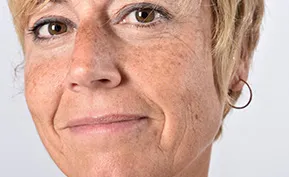
Mohs micrographic surgery is a technique used by specially trained dermatologic surgeons to treat high-risk skin cancers.
Invented in the 1930s by Dr. Frederic Mohs, it has become the gold standard of treatment for high-risk skin cancers, particularly for those on the head and neck, because of its very high cure rates.
While small low-risk basal cell carcinomas and squamous cell carcinomas can be effectively treated with excision or local destruction, Mohs surgery is recommended for skin cancers in critical areas such as the central face and ears, as well as for large or deep tumors, recurrent tumors, and tumors with aggressive features under the microscope.
After the cancerous cells have been completely removed, the defect can be repaired.
Most patients can be repaired by Dr. Ratner in the office immediately after the skin cancer has been cleared. The patient goes home with a bandage over the area and specific instructions for wound care and follow-up.
At times, patients are referred for repair by another surgical subspecialist.
Dr. Ratner completed a two-year fellowship training program in Mohs micrographic surgery and reconstruction, and has over 25 years of experience. She has performed over 20,000 Mohs surgery cases over the course of her career, and she and her staff are committed to providing excellent, compassionate care to all of their patients.
Many patients are surprised that their surgical wound is larger than they expected. This is frequently because the cancerous cells extended beyond the obvious external margins of the tumor. While the goal of Mohs surgery is to completely remove each skin cancer, the next goal is to provide each patient with the best possible functional and cosmetic result.
At times, the wound is small enough to heal on its own. There are certain areas of the body where nature will heal a wound as nicely as a surgical procedure. If the resultant scar is unacceptable, reconstructive surgery can be performed later.
In most cases, Dr. Ratner reconstructs the wound to help it to heal more quickly and to obtain a better long-term cosmetic outcome.
Closing the wound in a linear fashion with stitches is often the best option, as this is straightforward to perform and typically provides an excellent cosmetic result. If insufficient skin laxity is available, a skin flap may be required. Skin flaps release adjacent skin to cover the surgical defect, providing an excellent cosmetic match with the surrounding skin, and frequently hiding within the patient’s preexisting facial lines.
Skin grafts are performed when insufficient skin laxity is available to repair the surgical defect. Full thickness skin grafts are taken from an area of skin matching as closely as possible with the site to be repaired. After the graft is harvested, it is trimmed to fit the defect and sewn into place. The donor site is repaired with sutures as well.
Cartilage grafts are used when structural support is required to optimize healing of defects on the nose and ear. The cartilage is often harvested from the back of the ear. The donor site is then sutured, and the cartilage graft secured within the defect to prevent contraction during healing. A flap or graft is generally performed immediately thereafter to repair the remaining skin defect.
If a patient’s surgery is likely to be extensive, Dr. Ratner may recommend that they see another surgical specialist for consultation. If a reconstructive surgeon has referred the patient to Dr. Ratner, Dr. Ratner will perform the Mohs surgeon and the outside surgeon will perform that patient’s repair. In these cases, Dr. Ratner’s staff will work with the surgeon’s office to coordinate the Mohs surgery and the repair.
Mohs surgery is performed on an outpatient basis under local anesthesia. This technique differs from standard excision in that the surgeon is also the pathologist examining the tissue under the microscope. This allows the surgeon to map and evaluate 100% of the peripheral and deep margins of the specimen and precisely pinpoint any areas where cancer cells remain, ensuring that the narrowest possible margin can be removed. A specially trained histology technician prepares the sample while the patient waits, and results are usually ready within several hours. If additional tissue removal is required, that is performed immediately.
Whatever treatment you need, Désirée Ratner, M.D., P.C., can help. Please reach out to us today at (212) 814-5884 to discuss your skin cancer situation and treatment options. We look forward to speaking with you.
Désirée Ratner, M.D., P.C.
115 East 61st Street, 9th Floor
New York, NY 10065
Phone: (212) 814-5884
Get Directions